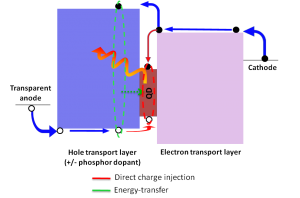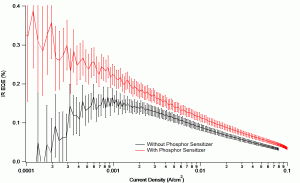Phosphor Sensitized Quantum-dot Light-emitting Diodes
- Category: Electronic Devices, Nanotechnology, Optics & Photonics
- Tags: Geoffrey Supran, Vladimir Bulovic
Colloidal quantum-dot light-emitting diodes (QD-LEDs) combine the thin film processability of organic materials with the tunable optical properties conferred by QD size control. Archetypal QD-LED architectures have, to date, typically comprised a monolayer of QDs sandwiched between organic hole- and electron-transporting layers (HTL/ETL) (see Figure 1). Two possible QD excitation mechanisms have previously been proposed (Figure 1): (red) direct carrier injection from organic transport layers into QDs, followed by exciton generation and recombination; and (green) Förster resonant energy transfer (FRET) of an exciton – initially generated in an organic transport layer – to the QD monolayer, followed by exciton recombination. Previous work [1] has demonstrated QD-LED systems in which the latter process appears to dominate. However, to date, all such architectures have comprised fluorescent small-molecule organics. Electrical excitation in the organic transport layer results in the creation of approximately one singlet exciton for every three triplet excitons [2] yet the latter typically go to waste because the lack of triplet oscillator strength in fluorophores prevents energy transfer. The possibility of harnessing these triplet states to as much as quadruple the efficiency of QD excitation motivates our ongoing efforts to use a phosphorescent sensitizer as a FRET donor for QDs. Analogous phosphor sensitization reported by Baldo et al [3] provides precedent for this work.
As a test bed for the study of phosphor sensitization, we have fabricated QD-LEDs (Figure 1) comprising monolayers of lead-sulfide (PbS) QDs (which yield near-infrared emission), obtained by micro-contact printing, previously reported by our group [4] . Devices with and without phosphor dopants in the hole-transport layer were compared. An increase in external quantum efficiency (EQE) upon introduction of the phosphor sensitizer was observed (Figure 2), though its extent (~ 20 to 50 %) was relatively slight, hinting at the possibility that direct charge injection may also play a role in the excitation of narrow band-gap QDs. To this end, we are currently investigating devices with wider band-gap QDs and employing steady-state and transient photoluminescence and photoluminescence excitation measurements to select complementary donor/acceptor systems.
- Figure 1: Energy band-diagram of QD-LED, illustrating two possible QD excitation mechanisms: (i) (red) direct carrier injection; and (ii) (green) Förster resonant energy transfer.
- Figure 2: EQE of IR QD-LEDs both with and without a phosphor doped hole-transport layer.
- P. O. Anikeeva, C. F. Madigan, J. E. Halpert, M. G. Bawendi, and V. Bulović, “Electronic and excitonic processes in light-emitting devices based on organic materials and colloidal quantum dots,” Physical Review B, vol. 78, pp. 085434-1 – 085424-8, Aug. 2008. [↩]
- M. A. Baldo, D. F. O’Brien, M. E. Thompson, and S. R. Forrest, “The excitonic singlet-triplet ratio in a semiconducting organic thin film,” Phys. Rev. B, vol. 60, pp. 14422–14428, Nov. 1999. [↩]
- M. A. Baldo, M. E. Thompson, and S. R. Forrest, “High-efficiency fluorescent organic light-emitting devices using a phosphorescent sensitizer,” Nature, vol. 403, pp. 750-753, Feb. 2000. [↩]
- L. Kim, P. O. Anikeeva, S. A. Coe-Sullivan, J. S. Steckel, M. G. Bawendi, and V. Bulović, “Contact printing of quantum dot light-emitting devices,” Nano Letters, vol. 8, pp. 4513-4517, Oct. 2008. [↩]

